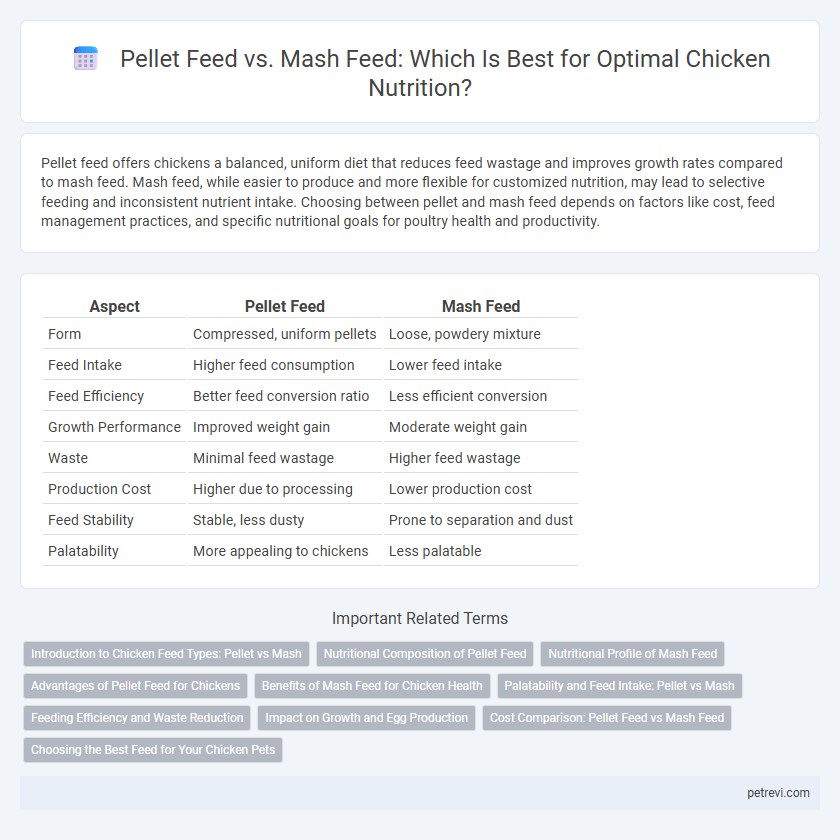Pellet feed offers chickens a balanced, uniform diet that reduces feed wastage and improves growth rates compared to mash feed. Mash feed, while easier to produce and more flexible for customized nutrition, may lead to selective feeding and inconsistent nutrient intake. Choosing between pellet and mash feed depends on factors like cost, feed management practices, and specific nutritional goals for poultry health and productivity.
Table of Comparison
| Aspect | Pellet Feed | Mash Feed |
|---|---|---|
| Form | Compressed, uniform pellets | Loose, powdery mixture |
| Feed Intake | Higher feed consumption | Lower feed intake |
| Feed Efficiency | Better feed conversion ratio | Less efficient conversion |
| Growth Performance | Improved weight gain | Moderate weight gain |
| Waste | Minimal feed wastage | Higher feed wastage |
| Production Cost | Higher due to processing | Lower production cost |
| Feed Stability | Stable, less dusty | Prone to separation and dust |
| Palatability | More appealing to chickens | Less palatable |
Introduction to Chicken Feed Types: Pellet vs Mash
Pellet feed for chickens consists of compressed, uniform-sized particles that enhance feed intake and reduce waste, promoting better growth performance. Mash feed is a loose mixture of ground grains and nutrients that allows chickens to select individual ingredients but may result in uneven nutrient consumption. Understanding the differences between pellet and mash feed is crucial for optimizing chicken nutrition and improving overall flock health.
Nutritional Composition of Pellet Feed
Pellet feed for chickens offers a uniform and balanced nutritional composition, providing essential proteins, vitamins, and minerals in each pellet to support optimal growth and health. The compact form reduces feed wastage and encourages better intake, ensuring consistent delivery of nutrients such as amino acids, calcium, and phosphorus crucial for bone development and egg production. Compared to mash feed, pellet feed enhances digestibility and nutrient absorption, contributing to improved feed conversion ratios and overall poultry performance.
Nutritional Profile of Mash Feed
Mash feed for chickens offers a balanced nutritional profile rich in essential proteins, vitamins, and minerals that support optimal growth and egg production. Its loose texture allows for easy digestion and absorption of nutrients such as amino acids, calcium, and phosphorus, which are critical for bone development and feather quality. Compared to pellet feed, mash feed enables precise formulation adjustments to meet specific dietary requirements during different growth stages.
Advantages of Pellet Feed for Chickens
Pellet feed offers enhanced nutrient density and reduces feed wastage in chicken nutrition by preventing selective eating and feed separation. This form promotes better growth performance, improved feed conversion ratio (FCR), and easier handling and storage compared to mash feed. Consistent pellet size also supports uniform intake, leading to healthier and more productive poultry flocks.
Benefits of Mash Feed for Chicken Health
Mash feed enhances chicken digestion by providing a uniform texture that promotes better nutrient absorption and supports gut health. It reduces feed wastage compared to pellets, ensuring chickens receive consistent nutrition, which leads to improved growth rates and stronger immune systems. The varied particle size in mash feed stimulates natural feeding behaviors, contributing to overall well-being and stress reduction in poultry.
Palatability and Feed Intake: Pellet vs Mash
Pellet feed for chickens offers enhanced palatability due to its uniform texture and compact form, encouraging higher feed intake compared to mash feed, which is loose and less consistent. Studies show chickens consuming pellet feed exhibit improved growth performance and feed efficiency as pellets reduce feed wastage and ease of ingestion. Mash feed, though often cheaper, may lead to selective eating and lower overall consumption, impacting nutrient intake and growth rates negatively.
Feeding Efficiency and Waste Reduction
Pellet feed offers higher feeding efficiency for chickens due to its uniform size and density, which reduces selective feeding and ensures balanced nutrient intake. Mash feed tends to increase feed wastage as chickens may sift through the particles, leading to uneven consumption and nutrient imbalance. Optimizing chicken nutrition with pellet feed can enhance growth performance and minimize feed waste, lowering production costs significantly.
Impact on Growth and Egg Production
Pellet feed enhances chicken growth rates and egg production by providing uniform nutrient intake and reducing feed wastage compared to mash feed. Studies show that pellet-fed chickens exhibit higher feed conversion ratios and improved weight gain due to better digestibility and palatability. Egg-laying hens on pellet diets produce larger eggs with stronger shells, reflecting optimized nutrient absorption critical for reproductive performance.
Cost Comparison: Pellet Feed vs Mash Feed
Pellet feed typically costs more to produce than mash feed due to the additional processing and pelletizing steps involved, but it offers improved feed conversion efficiency and reduced wastage. Mash feed is generally cheaper per ton, making it a cost-effective choice for small-scale or backyard poultry farmers. When evaluating overall cost-effectiveness, pellet feed may provide better economic returns despite higher upfront costs because of enhanced growth rates and feed utilization.
Choosing the Best Feed for Your Chicken Pets
Pellet feed offers uniform nutrition and reduces feed wastage, making it a highly efficient choice for chicken nutrition. Mash feed, while less processed, allows chickens to naturally forage and can improve digestion due to its coarse texture. Selecting the best feed depends on your chickens' age, health requirements, and feeding environment to optimize growth and overall well-being.
Pellet Feed vs Mash Feed for Chicken Nutrition Infographic

 petrevi.com
petrevi.com